Advances in La-Based High-k Dielectrics for MOS Applications
Abstract
:1. Introduction
2. Characteristics of La-Based High-k Dielectrics
2.1. Hygroscopicity of La2O3
2.2. Defects in La2O3
2.3. Effects of La on La-doped Ternary Oxides
3. Applications of La-based High-k Gate Dielectrics
3.1. Nonvolatile Memory
3.2. Metal-oxide-semiconductor Field-effect Transistors (MOSFETs)
3.3. Thin-film Transistors (TFTs)
3.4. Ge and III-V Metal-oxide-semiconductor (MOS) Devices
3.5. Other Novel Metal-oxide-semiconductor (MOS) Devices
4. Conclusions and Future Prospects
Author Contributions
Funding
Conflicts of Interest
References
- Wong, H. Nano-CMOS Gate Dielectric Technology; CRC Press: Boca Raton, FL, USA, 2011; p. 3. [Google Scholar]
- Wong, H.; Iwai, H. On the scaling issues and high-k replacement of ultrathin gate dielectrics for nanoscale MOS transistors. Microelectron. Eng. 2006, 83, 1867–1904. [Google Scholar] [CrossRef]
- Chindalore, G.; Hareland, S.A.; Jallepalli, S.; Tasch, A.F.; Maziar, C.M.; Chia, V.K.F.; Smith, S. Experimental determination of threshold voltage shifts due to quantum mechanical effects in MOS electron and hole inversion layers. IEEE Electron. Device Lett. 1997, 18, 206–208. [Google Scholar] [CrossRef]
- Depas, M.; Vermeire, B.; Mertens, P.W.; van Meirhaeghe, R.L.; Heyns, M.M. Determination of tunneling parameters in ultra-thin oxide layer poly-Si/SiO2/Si structurs. Solid-State Electron. 1995, 38, 1465–1471. [Google Scholar] [CrossRef]
- Lo, S.H.; Buchanan, D.A.; Taur, Y.; Wang, W. Quantum-mechenical modeling of electrontunneling current from the inversion layer of ultra-thin-oxide nMOSFET’s. IEEE Electron. Device Lett. 1997, 18, 209–211. [Google Scholar] [CrossRef]
- Lenzlinger, M.; Snow, E.H. Fowler-Nordheim tunneling into thermally grown SiO2. J. Appl. Phys. 1969, 40, 278–283. [Google Scholar] [CrossRef]
- Poole, H.H. On the dielectric constant and electrical conductivity of mica in intense fields. Philos. Mag. 1916, 32, 112–119. [Google Scholar] [CrossRef]
- Frenkel, J. On pre-breakdown phenomena in insulators and electronic semiconductors. Phys. Rev. 1938, 54, 647–648. [Google Scholar] [CrossRef]
- Gao, F.; Lee, S.J.; Chi, D.Z.; Balakumar, S.; Kwong, D.L. GaAs metal-oxide-semiconductor device with HfO2/TaN gate stack and thermal nitridation surface passivation. Appl. Phys. Lett. 2007, 90, 252904-1–252904-4. [Google Scholar] [CrossRef]
- Howssa, M.; Stesmans, A.; Heyns, M.M. Model for the trap-assisted tunneling current through very thin SiO2/ZrO2 gate dielectric stacks. Semicond. Sci. Technol. 2001, 16, 427–432. [Google Scholar] [CrossRef]
- Schuegraf, K.F.; King, C.C.; Hu, C. Ultra-thin silicon dioxide leakage current and scaling limit. In Proceedings of the Symposium on VLSI Technology Digest of Technical Papers, Seattle, WA, USA, 2–4 June 1992; pp. 18–19. [Google Scholar]
- Kirsch, K.S.; Sodini, C.G. Suppression of interface-state generation in reoxidized nitride oxide gate dielectrics. J. Appl. Phys. 1994, 76, 2284–2292. [Google Scholar] [CrossRef]
- Buchanan, D.A.; Marwick, A.D.; DiMaria, D.J.; Dori, L. Hot-electron-induced hydrogen redistribution and defect generation in metal-oxide-semiconductor capacitors. J. Appl. Phys. 1994, 76, 3595–3608. [Google Scholar] [CrossRef]
- Robertson, J. Band structures and band offsets of high k dielectrics on Si. Appl. Surf. Sci. 2001, 190, 2–10. [Google Scholar] [CrossRef]
- Robertson, J.; Falabretti, B. Band offsets of high-k gate oxides on III-V semiconductros. J. Appl. Phys. 2006, 100, 014111. [Google Scholar] [CrossRef]
- Houssa, M.; Pantisano, L.; Ragnarsson, L.; Degraeve, R.; Schram, T.; Pourtois, G.; Gendt, S.D.; Groeseneken, G. Electrical properties of high-k dielectrics: Challenges, current issues, and possible solutions. Mater. Sci. Eng. R Rep. 2006, 51, 37–85. [Google Scholar] [CrossRef]
- Almeida, R.M.C.; Baumvol, I.J.R. Reaction-diffusion in high-k dielectrics on Si. Surf. Sci. Rep. 2003, 49, 1–114. [Google Scholar] [CrossRef]
- Mistry, K.; Allen, C.; Auth, C.; Beattie, B.; Bergstrom, D.; Bost, M.; Brazier, M.; Buehler, M.; Cappellani, A.; Chau, R.; et al. A 45nm logic technology with High-k metal gate transistors, strained silicon, 9 Cu interconnect layers, 193nm dry patterning and 100% Pb-free packaging. In Proceedings of the IEEE International Electron Devices Meeting, Washington, DC, USA, 10–12 December 2007; pp. 247–250. [Google Scholar]
- Choi, J.H.; Mao, Y.; Chang, J.P. Development of hafnium based high-k materials—A review. Mater. Sci. Eng. R Rep. 2011, 72, 97–136. [Google Scholar] [CrossRef]
- Clark, R.D. Emerging applications for high-k materials in VLSI technology. Materials 2014, 7, 2913–2944. [Google Scholar] [CrossRef]
- Zhang, X.H.; Domercq, B.; Wang, X.; Yoo, S.; Kondo, T.; Wang, Z.L.; Kippelen, B. High-performance pentacene field-effect transistors using Al2O3 gate dielectrics prepared by atomic layer deposition. Org. Electron. 2007, 8, 718–726. [Google Scholar] [CrossRef]
- Wang, B.; Huang, W.; Chi, L.; Al-Hasimi, M.; Marks, T.J.; Facchetti, A. High-k gate dielectrics for emerging flexible and stretchable electronics. Chem. Rev. 2018, 118, 5690–5754. [Google Scholar] [CrossRef]
- Shim, J.H.; Choi, H.J.; Kim, Y.; Torgersen, J.; An, J.; Lee, M.H.; Prinz, F.B. Process-property relationship in high-k ALD SrTiO3 and BaTiO3: A review. J. Mater. Chem. C 2017, 5, 8000–8013. [Google Scholar] [CrossRef]
- Huang, L.; Jia, Z.; Kymissis, I.; O’Brien, S. High-k capacitors and OFET gate dielectrics from self-assembled BaTiO3 and (Ba, Sr)TiO3 nanocrystals in the superparaelectric limit. Adv. Funct. Mater. 2010, 20, 554–560. [Google Scholar] [CrossRef]
- Joshi, N.J.; Grewal, G.S.; Shrinet, V.; Govindan, T.P. Synthesis and dielectric behavior of nano-scale barium titanate. IEEE Trans. Dielectr. Electr. Insul. 2012, 19, 83–90. [Google Scholar] [CrossRef]
- Zheng, M.S.; Zheng, Y.T.; Zha, J.W.; Yang, Y.; Han, P.; Wen, Y.Q.; Dang, Z.M. Improved dielectric, tensile and energy storage properties of surface rubberized BaTiO3/polypropylene nanocomposites. Nano Energy 2018, 48, 144–151. [Google Scholar] [CrossRef]
- Wang, X.; Liu, H.; Fei, C.; Yin, S.; Fan, X. Silicon diffusion control in atomic-layer-deposited Al2O3/La2O3/Al2O3 gate stacks using an Al2O3 barrier layer. Nanoscale Res. Lett. 2015, 10, 141-1–141-6. [Google Scholar] [CrossRef]
- Shang, G.; Peacock, P.W.; Robertson, J. Stability and band offsets of nitrogenated high-dielectric-constant gate oxides. Appl. Phys. Lett. 2004, 84, 106–108. [Google Scholar] [CrossRef]
- Wu, Y.H.; Yang, M.Y.; Chin, A.; Chen, W.J.; Kwei, C.M. Electrical characteristics of high quality La2O3 gate dielectric with equivalent oxide thickness of 5 Å. IEEE Electron. Device Lett. 2000, 21, 341–343. [Google Scholar] [CrossRef]
- Chin, A.; Wu, Y.H.; Chen, S.B.; Liao, C.C.; Chen, W.J. High quality La2O3 and Al2O3 gate dielectrics with equivalent oxide thickness 5–10 Å. In Proceedings of the 2000 Symposium on VLSI Technology. Digest of Technical Papers, Honolulu, HI, USA, 13–15 June 2000; pp. 16–17. [Google Scholar]
- Iwai, H.; Ohmi, S.; Akama, S.; Ohshima, C.; Kikuchi, A.; Kashiwagi, I.; Taguchi, J.; Yamamoto, H.; Tonotani, J.; Kim, Y.; et al. Advanced gate dielectric materials for sub-100 nm CMOS. In Proceedings of the IEEE Digest. International Electron Devices Meeting, San Francisco, CA, USA, 8–11 December 2002; pp. 625–628. [Google Scholar]
- Wu, H.; Zhao, Y.; White, M.H. Quantum mechanical modeling of MOSFET gate leakage for high-k gate dielectrics. Solid States Electron. 2006, 50, 1164–1169. [Google Scholar] [CrossRef]
- Gonzales-Elipe, A.R.; Espinos, J.P.; Fernandez, A.; Munuera, G. XPS study of the surface carbonation/hydroxylation state of metal oxides. Appl. Surf. Sci. 1990, 45, 103–108. [Google Scholar] [CrossRef]
- Devine, R.A.B. Infrared and electrical properties of amorphous sputtered (LaxAl1-x)2O3. J. Appl. Phys. 2003, 93, 9938–9942. [Google Scholar] [CrossRef]
- Jin, H.J.; Choi, D.J.; Kim, K.H.; Oh, K.Y.; Hwang, C.J. Effect of structural properties on electrical properties of Lanthanum oxide thin film as a gate dielectric. Jpn. J. Appl. Phys. 2003, 42, 3519–3522. [Google Scholar] [CrossRef]
- Yamada, H.; Shmizu, T.; Kurokawa, A.; Ishii, K.; Suzuki, E. MOCVD of high-dielectric-constant lanthanum oxide thin films. J. Electrochem. Soc. 2003, 150, G429–G435. [Google Scholar] [CrossRef]
- Zhao, Y. Design of higher-k and more stable rare earth oxides as gate dielectrics for advanced CMOS devices. Materials 2012, 5, 1413–1438. [Google Scholar] [CrossRef]
- He, G.; Sun, Z. High-k Gate Dielectrics for CMOS Technology; Wiley-VCH: Hoboken, NJ, USA, 2012; p. 189. [Google Scholar]
- Mortimer, R.G. Physical Chemistry, 2nd ed.; Academic Press: New York, NY, USA, 2000. [Google Scholar]
- Morant, C.; Sanz, J.M.; Galan, L.; Soriano, L.; Rueda, F. An XPS study of the interaction of oxygen with zirconium. Surf. Sci. 1989, 218, 331–345. [Google Scholar] [CrossRef]
- Han, C.Y.; Tang, W.M.; Leung, C.H.; Che, C.M.; Lai, P.T. High-mobility pentacene thin-film transistor by using LaxTa(1-x)Oy as gate dielectric. Org. Electron. 2014, 15, 2499–2504. [Google Scholar] [CrossRef]
- Song, J.Q.; Han, C.Y.; Lai, P.T. Comparative study of Nb2O5, NbLaO, and La2O3 as gate dielectric of InGaZnO thin-film transistor. IEEE Trans. Electron. Device 2016, 63, 1928–1933. [Google Scholar] [CrossRef]
- Zhao, Y.; Kita, K.; Kyuno, K.; Toriumi, A. Mechanisms of and solutions to moisture absorption of Lanthanum oxide as high-k gate dielectric. ECS Trans. 2007, 6, 141–148. [Google Scholar]
- Ragnarsson, L.A.; Guha, S.; Copel, M.; Cartier, E.; Bojarczuk, N.A.; Karasinski, J. Molecular-beam-deposited yttrium-oxide dielectrics in aluminum-gated metal-oxide-semiconductor field-effect transistors: Effective electron mobility. Appl. Phys. Lett. 2001, 78, 4169–4171. [Google Scholar] [CrossRef]
- Bersuker, G.; Zeitzoff, P.; Brown, G.; Huff, H.R. Dielectrics for future transistors. Mater. Today 2004, 7, 26–33. [Google Scholar] [CrossRef]
- Gusev, E.P.; Buchanan, D.A.; Cartier, E.; Kumar, A.; DiMaria, D.; Guha, S.; Callegari, A.; Zafar, S.; Jamison, P.C.; Neumayer, D.A.; et al. Ultrathin high-k gate stacks for advanced CMOS devices. In Proceedings of the IEEE Technical Digest, International Electron Devices Meeting, Washington, DC, USA, 2–5 December 2001; pp. 20.1.1–20.1.4. [Google Scholar]
- Zafar, S.; Callegari, A.; Gusev, E.; Fischetti, M. Charge trapping related threshold voltage instabilities in high permittivity gate dielectric stacks. J. Appl. Phys. 2003, 93, 9298–9303. [Google Scholar] [CrossRef]
- Fischetti, M.V.; Neumayer, D.A.; Cartier, E.A. Effective electron mobility in Si inversion layers in metal-oxide-semiconductor systems with a high-k insulator: The role of remote phonon scattering. J. Appl. Phys. 2001, 90, 4587–4608. [Google Scholar] [CrossRef]
- Raghavan, N.; Pey, K.L.; Li, X. Detection of high-k and interfacial layer breakdown using the tunneling mechanism in a dual layer dielectric stack. Appl. Phys. Lett. 2009, 95, 022903. [Google Scholar] [CrossRef]
- Kohan, A.F.; Ceder, G.; Morgan, D.; van de Walle, C.G. First-principles study of native point defects in ZnO. Phys. Rev. B 2000, 61, 15019–15027. [Google Scholar] [CrossRef]
- Xiong, K.; Peacock, P.W.; Robertson, J. Defect energy levels in HfO2, ZrO2, La2O3 and SrTiO3. Mater. Res. Soc. Symp. Proc. 2004, 811, D.6.4.1–D.6.4.5. [Google Scholar] [CrossRef]
- Xiong, K.; Robertson, J.; Clark, S.J. Passivation of oxygen vacancy states in HfO2 by nitrogen. J. Appl. Phys. 2006, 99, 044105. [Google Scholar] [CrossRef]
- Sen, B.; Wong, H.; Molina, J.; Iwai, H.; Ng, J.A.; Kakushima, K.; Sarkar, C.K. Trapping characteristics of lanthanum oxide gate dielectric film explored from temperature current-voltage and capacitance-voltage measurements. Solid States Electron. 2007, 57, 475–480. [Google Scholar] [CrossRef]
- Zheng, J.X.; Ceder, G.; Chim, W.K. First-principles study on the concentrations of native point defects in high-dielectric-constant binary oxide materials. Phys. Stat. Sol. Rap. Res. Lett. 2008, 2, 227–229. [Google Scholar] [CrossRef]
- Wong, H.; Zou, J.; Zhang, J.; Jin, H.; Kakushima, K.; Iwai, H. The interfaces of lanthanum oxide-based subnanometer EOT gate dielectrics. Nanoscale Res. Lett. 2014, 9, 472-1–472-5. [Google Scholar] [CrossRef] [PubMed]
- Song, J.; Kakushima, K.; Ahmet, P.; Tsutsui, K.; Sugii, N.; Hattori, T.; Iwai, H. Improvement of interfacial properties with interfacial layer in La2O3/Ge structure. Microelectron. Eng. 2007, 84, 2336–2339. [Google Scholar] [CrossRef]
- Kakushima, K.; Seki, T.; Wakabayashi, H.; Tsutsui, K.; Iwai, H. Infrared spectroscopic analysis of reactively formed La-silicate interface layer at La2O3/Si substrates. Vacuum 2016, 140, 14–18. [Google Scholar] [CrossRef]
- Mamatrishat, M.; Kubota, T.; Seki, T.; Kakushima, K.; Ahmet, P.; Tsutsur, K.; Kataoka, Y.; Nishiyama, A.; Sugii, N.; Natori, K.; et al. Oxide and interface trap densities estimation in ultrathin W/La2O3/Si MOS capacitors. Microelectron. Reliab. 2012, 52, 1039. [Google Scholar] [CrossRef]
- Nabatame, T.; Ohi, A.; Chikyow, T. Role of oxygen transfer for high-k/SiO2/Si stack structure on flatband voltage shift. ECS Trans. 2011, 35, 403–416. [Google Scholar]
- Bauza, D.; Ghobar, O.; Guillaumot, B. On the depth profiling of the traps in MOSFET’s with high-k gate dielectrics. ECS Trans. 2007, 6, 219–227. [Google Scholar]
- Huang, X.D.; Liu, L.; Xu, J.P.; Lai, P.T. Nitrided La2O3 as charge trapping layer for nonvolatile memory applications. IEEE Trans. Device Mater. Reliab. 2012, 12, 306–310. [Google Scholar] [CrossRef]
- Lin, L.M.; Lai, P.T. High-k gate stack HfxTi1-xON/SiO2 for SiC MOS devices. J. Mater. Sci.-Mater. Electron. 2008, 19, 894–897. [Google Scholar] [CrossRef]
- Yamamoto, Y.; Kita, K.; Kyuno, K.; Toriumi, A. Structural and electrical properties of HfLaOx films for an amorphous high-k gate insulator. Appl. Phys. Lett. 2006, 89, 032903. [Google Scholar] [CrossRef]
- Loo, Y.F.; Taylor, S.; Murray, R.T.; Jones, A.C.; Chalker, P.R. Structural and electrical characterization of amorphous lanthanum hafnium oxide thin films. J. Appl. Phys. 2006, 99, 103704-1–103704-4. [Google Scholar] [CrossRef]
- Wang, X.P.; Li, M.F.; Cin, A.; Zhu, C.X.; Shao, J.; Lu, W.; Shen, X.C.; Yu, X.F.; Chi, R.; Shen, C.; et al. Physical and electrical charactistics of high-k dielectric Hf(1-x)LaxOy. Solid-State Electron. 2006, 50, 986–991. [Google Scholar] [CrossRef]
- Wang, X.P.; Shen, C.; Li, M.; Yu, H.Y.; Sun, Y.; Feng, Y.P.; Lim, A.; Sik, H.W.; Chin, A.; Yeo, Y.C.; et al. Dual metal gates with band-edge work functions on novel HfLaO high-k gate dielectric. In Proceedings of the 2006 Symposium on VLSI Technology, Honolulu, HI, USA, 13–15 June 2006; pp. 9–10. [Google Scholar]
- Nmezawa, N.; Shiraishi, K.; Sugino, S.; Tachibana, A.; Ohmori, K.; Kakushima, K.; Iwai, H.; Chikyow, T.; Ohno, T.; Nara, Y.; et al. Suppression of oxygen vacancy formation in Hf-based high-k dielectrics by lanthanum incorporation. Appl. Phys. Lett. 2007, 91, 132904. [Google Scholar]
- Liu, D.; Robertson, J. Passivation of oxygen vacancy states and suppression of Fermi pinning in HfO2 by La addition. Appl. Phys. Lett. 2009, 94, 042904. [Google Scholar] [CrossRef]
- Guha, S.; Paruchuri, V.K.; Copel, M.; Narayanan, V.; Wang, Y.Y.; Batson, P.E.; Bojarczuk, N.A.; Linder, B.; Doris, B. Examination of flatband and threshold voltage tuning of HfO2/TiN field effect transistors by dielectric cap layers. Appl. Phys. Lett. 2007, 90, 092902. [Google Scholar] [CrossRef]
- Alshareef, H.N.; Quevedo-Lopez, M.; Wen, H.C.; Harris, R.; Kirsch, P.; Majhi, P.; Lee, B.H.; Jammy, R.; Lichtenwalner, D.J.; Jur, J.S.; et al. Work function engineering using lanthanum oxide interfacial layers. Appl. Phys. Lett. 2006, 89, 232103. [Google Scholar] [CrossRef]
- Yamamoto, Y.; Kita, K.; Kyuno, K.; Toriumi, A. Study of La-induced flat band voltage shift in metal/HfLaOx/SiO2/Si. Jap. J. Appl. Phys. 2007, 46, 7251–7255. [Google Scholar] [CrossRef]
- Suarez-Segovia, C.; Leroux, C.; Domengie, F.; Ghibaudo, G. Quantitative analysis of La and Al additives role on dipole magnitude inducing Vt shift in high-k/metal gate stack. IEEE Electron. Device Lett. 2017, 38, 379–382. [Google Scholar] [CrossRef]
- Kirsch, P.D.; Sivasubramani, P.; Huang, J.; Young, C.D.; Quevedo-Lopez, M.A.; Wen, H.C.; Alshareef, H.; Choi, K.; Park, C.S.; Freeman, K.; et al. Dipole model explaining high-k/metal gate field effect transistor threshold voltage tuning. Appl. Phys. Lett. 2008, 92, 092901. [Google Scholar] [CrossRef]
- Lin, L.; Robertson, J. Atomic mechanism of electric diplole formed at high-k: SiO2 interface. J. Appl. Phys. 2011, 109, 094502. [Google Scholar] [CrossRef]
- Kita, K.; Toriumi, A. Origin of electric dipoles formed at high-k/SiO2 interface. Appl. Phys. Lett. 2007, 94, 132902. [Google Scholar] [CrossRef]
- Zhao, C.Z.; Zhang, J.F.; Zahid, M.B.; Groeseneken, C.; Degraeve, R.; de Gendt, S. Impact of gate materials on positive charge formation in HfO2/SiO2 stacks. Appl. Phys. Lett. 2006, 89, 023507. [Google Scholar] [CrossRef]
- Zhao, C.; Zhao, C.Z.; Taylor, S.; Chalker, P.R. Review on non-volatile memory with high-k dielectrics: Flash for generation beyond 32 nm. Materials 2014, 7, 5117–5145. [Google Scholar] [CrossRef]
- Lee, C.H.; Hur, S.H.; Shin, Y.C.; Choi, J.H.; Park, D.G.; Kim, K. Charge-trapping device structure of SiO2/SiN?high-k dielectric Al2O3 for high-density flash memory. Appl. Phys. Lett. 2005, 86, 152908. [Google Scholar] [CrossRef]
- He, W.; Pu, J.; Chan, S.H.; Cho, B.J. Performance improvement in charge-trap flash memory using lanthanum based high-k blocking oxide. IEEE Trans. Electron. Device 2009, 56, 2476–2751. [Google Scholar] [CrossRef]
- del Vitto, A.; Piagge, R.; Ravizza, E.; Spadoni, S.; Sebastiani, A.; Scozzari, C.; Wiemer, C.; Chidini, G.; Alessandri, M.; Fanciulli, M.; et al. Evaluation of HfLaOx as blocking layer for innovative nonvolatile memory applications. ECS Trans. 2010, 33, 417–424. [Google Scholar]
- Lina, S.H.; Chin, A.; Yeh, F.S.; McAlister, S.P. Good 150 °C retention and fast erase characteristics in charge-trap-engineered memory having a scaled Si3N4 layer. In Proceedings of the IEEE Technical Digest, International Electron Devices Meeting, San Francisco, CA, USA, 15–17 December 2008; pp. 1–4. [Google Scholar]
- Hyo, J.K.; Cha, S.Y.; Choi, D.J. Memory characteristics of Al2O3/La2O3/Al2O3 multi-layer films with various blocking and tunnel oxide thicknesses. Mater. Sci. Semicond. Process. 2010, 13, 9–12. [Google Scholar]
- Wu, Y.H.; Chen, L.L.; Lin, Y.S.; Li, M.Y.; Wu, H.C. Nitrided tetragonal ZrO2 as the charge-trapping layer for nonvolatile memory application. IEEE Electron. Device Lett. 2009, 30, 1290–1292. [Google Scholar]
- Shi, R.P.; Huang, X.D.; Leung, C.H.; Sin, J.K.O.; Lai, P.T. Nb-doped La2O3 as charge-trapping layer for nonvolatile memory applications. IEEE Device Mater. Reliab. 2015, 15, 123–126. [Google Scholar] [CrossRef]
- Huang, X.D.; Lai, P.T.; Sin, J.K.O. Performance of nonvolatile memory by suing band-engineered SrTiO3/HfON stack as charge-trapping layer. Microelectron. Reliab. 2012, 52, 2527–2531. [Google Scholar] [CrossRef]
- Zhang, G.; Ra, C.H.; Li, H.M.; Shen, T.Z.; Cheong, B.K.; Yoo, W.J. Modified potential well formed by Si/SiO2/TiN/TiO2/SiO2/TaN for flash memory application. IEEE Trans. Electron. Device 2010, 57, 2794–2800. [Google Scholar] [CrossRef]
- Fu, Y.Y.; Li, A.D.; Liu, X.J.; Wu, D.; Tang, Z.J. Characteristics of atomic layer deposition-derived all-high-k-based structures for flash memory application. Annual Non-volatile Memory Technol. Symp. Proc. 2011, 11, 1–4. [Google Scholar]
- Huang, X.D.; Lai, P.T. HfON/LaON as charge-trapping layer for nonvolatile memory applications. In Proceedings of the IEEE Conference of Electron Devices and Solid-State Circuits, Bangkok, Thailand, 3–5 December 2012; pp. 1–3. [Google Scholar]
- Alessandri, M.; del Vitto, A.; Piagge, R.; Sebastiani, A.; Scozzari, C.; Wimer, C.; Lamagna, L.; Perego, M.; Ghidini, G.; Fanciulli, M. Rare earth-based high-k materials for non-volatile memory application. Microelectron. Eng. 2010, 87, 290–293. [Google Scholar] [CrossRef]
- Huang, X.D.; Lai, P.T.; Sin, J.K.O. LaTiON/loan as band-engineered charge-trapping layer for nonvolatile memory applications. Appl. Phys. A 2012, 108, 229–234. [Google Scholar] [CrossRef]
- Kakushima, K.; Tachi, K.; Adachi, M.; Okamoto, K.; Sato, S.; Song, J.; Kawanago, T.; Ahmet, P.; Tsutsui, K.; Sugii, N.; et al. Interface and electrical properties of La-silicate for direct contact of high-k with silicon. Solid-State Electron. 2010, 54, 715–719. [Google Scholar] [CrossRef]
- Robertson, J. High dielectric constant gate oxides for metal oxide Si transistors. Rep. Prog. Phys. 2006, 69, 327–396. [Google Scholar] [CrossRef]
- Lim, S.G.; Driventsov, S.; Jackson, T.N.; Haeni, J.H.; Schlom, D.G.; Balbashov, A.M.; Vecker, R.; Reiche, P.; Freeouf, J.L.; Lucovsky, G. Dielectric functions and optical bandgaps of high-k dielectrics for metal-oxide-semiconductor field-effect transistors by far ultraviolet spectroscopic ellipsometry. J. Appl. Phys. 2002, 91, 4500–4505. [Google Scholar] [CrossRef]
- LEdge, F.; Schlom, D.G.; Chambers, S.A.; Cicerrella, E.; Freeouf, J.L.; Hollander, B.; Schubert, J. Measurement of the band offsets between amorphous LaAlO3 and silicon. Appl. Phys. Lett. 2004, 84, 726–728. [Google Scholar]
- Edge, L.F.; Schlom, D.G.; Brewer, R.T.; Chabal, Y.J.; Williams, J.R.; Chambers, S.A.; Hinkle, C.; Lucovsky, G.; Yang, Y.; Stemmer, S.; et al. Suppression of subcutaneous oxidation during the deposition of amorphous lanthanum aluminate on silicon. Appl. Phys. Lett. 2004, 84, 4629–4631. [Google Scholar] [CrossRef] [Green Version]
- Chang, I.Y.; You, S.; Juan, P.; Wang, M.; Lee, J.Y. The electrical and interfacial properties of metal-high-k oxide-semiconductor field-effect transistors with LaAlO3 gate dielectric. IEEE Electron. Device Lett. 2009, 30, 161–164. [Google Scholar] [CrossRef]
- Lu, X.B.; Lu, H.B.; Chen, Z.H.; Zhang, X.; Huang, R.; Zhou, H.W.; Wang, X.P.; Nguyen, B.Y.; Wang, C.Z.; Xiang, W.F.; et al. Field-effect transistors with LaAlO3 and LaAlOxNy gate dielectrics deposited by laser molecular-beam epitaxy. Appl. Phys. Lett. 2004, 85, 3543–3545. [Google Scholar] [CrossRef]
- Wang, X.P.; Li, M.F.; Ren, C.; Yu, X.F.; Shen, C.; Ma, H.H.; Chin, A.; Zhu, C.X.; Ning, J.; Yu, M.B.; et al. Tuning effective metal gate work function by a novel gate dielectric HfLaO for nMOSFETs. IEEE Electron. Device Lett. 2006, 27, 31–33. [Google Scholar] [CrossRef]
- Saeki, M.; Arimura, H.; Kitano, N.; Hosoi, T.; Shimura, T.; Watanabe, H. La induced passivation of high-k bulk and interface defects in polycrystalline silicon/TiN/HfLaSiO/SiO2 stacks. Jpn. J. Appl. Phys. 2011, 50, 10PA01. [Google Scholar] [CrossRef]
- Ahmet, P.; Nakagawa, K.; Kakushima, K.; Nohira, H.; Tsutsui, K.; Sugii, N.; Hattori, T.; Iwai, H. Electrical characteristics of MOSFETs with La2O3/Y2O3 gate stack. Microelectron. Reliab. 2008, 48, 1769–1771. [Google Scholar] [CrossRef]
- Henkel, C.; Abermann, S.; Bethge, O.; Pozzovivo, G.; Klang, P.; Stoger-pollach, M.; Bertagnolli, E. Schottky barrier SOI-MOSFETs with high-k La2O3/ZrO2 gate dielectrics. Microelectron. Eng. 2011, 88, 262–267. [Google Scholar] [CrossRef]
- Lin, S.H.; Cheng, C.H.; Chen, W.B.; Yeh, F.S.; Chin, A. Low-threshold-voltage TaN/LaTiO n-MOSFETs with small EOT. IEEE Electron. Device Lett. 2009, 30, 999–1001. [Google Scholar] [CrossRef]
- Ozben, E.D.; Lopes, J.M.J.; Nichau, A.; Schnee, M.; Lenk, S.; Besmehn, A.; Bourdelle, K.K.; Zhao, Q.T.; Schubert, J.; Mantl, S. Integration of LaLuO3 (k ~ 30) as high-k dielectric on strained and unstrained SOI MOSFETs with a replacement gate process. IEEE Electron. Device Lett. 2011, 32, 15–17. [Google Scholar] [CrossRef]
- Olyaei, M.; Malm, B.G.; Hellstrom, P.; Ostling, M. Low-frequency noise in high-k LaLuO3/TiN MOSFETs. Solid-State Electron. 2012, 78, 51–55. [Google Scholar] [CrossRef]
- Ghibaudo, G.; Boutchacha, T. Electrical noise and RTS fluctuations in advanced CMOS devices. Microelectron. Reliab. 2002, 42, 573–582. [Google Scholar] [CrossRef]
- Esro, M.; Mazzocco, R.; Vourlias, G.; Kolosov, O.; Krier, A.; Milne, W.I.; Adamopoulos, G. Solution processed lanthanum aluminate gate dielectrics for use in metal oxide-based thin film transistors. Appl. Phys. Lett. 2015, 106, 203507. [Google Scholar] [CrossRef] [Green Version]
- Ryu, M.K.; Yang, S.; Park, S.-H.K.; Hwang, C.-S.; Jeong, J.K. High performance thin film transistor with cosputtered amorphous Zn-In-Sn-O channel: Combinatorial approach. Appl. Phys. Lett. 2009, 95, 072104. [Google Scholar] [CrossRef]
- Jackson, W.; Hoffman, R.; Herman, G. High-performance flexible zinc tin oxide field-effect transistors. Appl. Phys. Lett. 2005, 87, 193503. [Google Scholar] [CrossRef]
- Ogo, Y.; Nomura, K.; Yanagi, H.; Kamiya, T.; Hirano, M.; Hosono, H. Amorphous Sn-Ga-Zn-O channel thin-film transistors. Phys. Status Solidi (A) 2008, 205, 1920–1924. [Google Scholar] [CrossRef]
- Kim, C.-J.; Kim, S.; Lee, J.-H.; Park, J.-S.; Kim, S.; Park, J.; Lee, E.; Lee, J.; Park, Y.; Kim, J.H.; et al. Amorphous hafnium-indium-zinc oxide semiconductor thin film transistors. Appl. Phys. Lett. 2009, 95, 252103-1–252103-3. [Google Scholar] [CrossRef]
- Paine, D.C.; Yaglioglu, B.; Beiley, Z.; Lee, S. Amorphous IZO-based transparent thin film transistors. Thin Solid Films 2008, 516, 5894–5898. [Google Scholar] [CrossRef]
- Nomura, K.; Ohta, H.; Takagi, A.; Kamiya, T.; Hirano, M.; Hosono, H. Room-temperature fabrication of transparent flexible thin-film transistors using amorphous oxide semiconductors. Nature 2004, 432, 488–492. [Google Scholar] [CrossRef] [PubMed]
- Su, N.C.; Wang, S.J.; Chin, A. High-performance InGaZnO thin-film transistors using HfLaO gate dielectric. IEEE Electron. Device Lett. 2009, 30, 1317–1319. [Google Scholar] [CrossRef]
- Qian, L.X.; Lai, P.T. A study on the electrical characteristics of InGaZnO thin-film transistor with HfLaO gate dielectric annealed in different gases. Microelectron. Reliab. 2014, 54, 2396–2400. [Google Scholar] [CrossRef] [Green Version]
- Qian, L.X.; Lai, P.T.; Tang, W.M. Effects of Ta incorporation in La2O3 gate dielectric of InGaZnO thin-film transistor. Appl. Phys. Lett. 2014, 104, 123505. [Google Scholar] [CrossRef]
- Huang, X.D.; Ma, Y.; Song, J.Q.; Lai, P.T. High-performance amorphous InGaZnO thin-film transistor with ZrLaO gate dielectric fabricated at room termperature. J. Disp. Technol. 2016, 12, 1522. [Google Scholar]
- Zheng, Z.W.; Cheng, C.H.; Chen, Y.C. Low operation voltage InGaZnO thin film transistors with LaAlO3 gate dielectric incorporation. ECS Trans. 2013, 2, N179–N181. [Google Scholar]
- Han, C.Y.; Tang, W.M.; Leung, C.H.; Che, C.M.; Lai, P.T. A study on La incorporation in transition-metal (Y, Zr, and Nb) oxides as gate dielectric of pentacene organic thin film transistor. IEEE Trans. Electron. Device 2015, 62, 2313–2319. [Google Scholar] [CrossRef]
- Chang, M.F.; Lee, P.T.; McAlister, S.P.; Chin, A. Low subthreshold swing HfLaO/Pentacene organic thin-film transistors. IEEE Electron. Device Lett. 2008, 29, 215–217. [Google Scholar] [CrossRef]
- Han, C.Y.; Tang, W.M.; Leung, C.H.; Che, C.M.; Lai, P.T. High performance pentacene thin-film transistor with high-kappa HfLaON as gate dielectric. IEEE Electron. Device Lett. 2013, 34, 1397–1399. [Google Scholar] [CrossRef]
- Han, C.Y.; Qian, L.X.; Leung, C.H.; Che, C.M.; Lai, P.T. High performance pentacene thin-film transistor with ZrLaO gate dielectric passivated by fluorine incorporation. Org. Electron. 2013, 14, 2973–2979. [Google Scholar] [CrossRef]
- Han, C.Y.; Song, J.Q.; Tang, W.M.; Leung, C.H.; Lai, P.T. High performance organic thin-film transistor by using LaNbO as gate dielectric. Appl. Phys. Lett. 2015, 107, 033503. [Google Scholar] [CrossRef]
- Chang, M.F.; Lee, P.T.; McAlister, S.P.; Chin, A. Small-subthreshold-swing and low-voltage flexible organic thin-film transistors which use HfLaO as the gate dielectric. IEEE Electron. Device Lett. 2009, 30, 133–135. [Google Scholar] [CrossRef]
- Han, C.Y.; Tang, W.M.; Lai, P.T. High-mobility pentacene organic thin-film transistor with LaxNb1-xOy gate dielectric fabricated on vacuum tape. IEEE Trans. Electron. Device 2017, 64, 1716–1722. [Google Scholar] [CrossRef]
- Wu, Y.; Feng, J.; Su, B.; Jiang, L. 3D dewetting for crystal patterning: Toward regular single crystalline belt arrays and their functionality. Adv. Mater. 2016, 28, 2266–2273. [Google Scholar] [CrossRef] [PubMed]
- Imoulas, A.D.; Tsoutsou, D.; Panayiotatos, Y.; Sotiropoulos, A.; Mavrou, G.; Galata, S.F.; Golias, E. The role of La surface chemistry in the passivation of Ge. Appl. Phys. Lett. 2010, 96, 012902. [Google Scholar] [CrossRef]
- Bethge, O.; Henkel, C.; Abermann, S.; Pozzovivo, G.; Stoeger-Pollach, M.; Werner, W.S.M.; Smoliner, J.; Bertagnolli, E. Stability of La2O3 and GeO2 passivated Ge surfaces during ALD or ZrO2 high-k dielectric. Appl. Surf. Sci. 2012, 258, 3444–3449. [Google Scholar] [CrossRef]
- Cheng, Z.X.; Liu, L.; Xu, J.P.; Huang, Y.; Lai, P.T.; Tang, W.M. Impact of nitrogen incorporation on the interface between Ge and La2O3 or Y2O3 gate dielectric: A study on the formation of germanate. IEEE Trans. Electron. Device 2016, 63, 4888–4892. [Google Scholar] [CrossRef]
- Xu, H.X.; Xu, J.P.; Li, C.X.; Lai, P.T. Improved electrical properties of Ge metal-oxide-semiconductor capacitors with high-k HfO2 gate dielectric by using La2O3 interlayer sputtered with/without N2 ambient. Appl. Phys. Lett. 2010, 97, 022903. [Google Scholar] [CrossRef]
- Xu, H.X.; Xu, J.P.; Li, C.X.; Chan, C.L.; Lai, P.T. Impacts of Ti on electrical properties of Ge metal-oxide-semiconductor capacitors with ultrathin high-k LaTiON gate dielectric. Appl. Phys. A 2010, 99, 903–906. [Google Scholar] [CrossRef]
- Ji, F.; Xu, J.P.; Huang, Y.; Liu, L.; Lai, P.T. Improved interfacial and electrical properties of Ge-based metal-oxide-semiconductor capacitor with LaTaON passivation layer. IEEE Trans. Electron. Device 2014, 61, 3608–3612. [Google Scholar]
- Cheng, Z.X.; Xu, J.P.; Liu, L.; Huang, Y.; Lai, P.T.; Tang, W.M. Improved interfacial and electrical properties of Ge MOS capacitor by using TaON/Loan dual passivation layer. Appl. Phys. Lett. 2016, 109, 023514-1–023514-5. [Google Scholar] [CrossRef]
- Chen, W.B.; Shie, B.S.; Chin, A. Higher gate capacitance Ge n-MOSFETs using laser annealing. IEEE Electron. Device Lett. 2011, 32, 449–451. [Google Scholar] [CrossRef]
- Ok, I.; Kim, H.S.; Zhang, M.H.; Kang, C.Y.; Rhee, S.J.; Choi, C.; Krishnan, S.A.; Lee, T.; Zhu, F.; Thareja, G.; et al. Metal gate-HfO2 MOS structures on GaAs substrate with and without Si interlayer. IEEE Electron. Lett. 2006, 27, 145–147. [Google Scholar] [CrossRef]
- Kim, H.S.; Ok, I.; Zhang, M.; Zhu, F.; Park, S.; Yum, J.; Zhao, H.; Lee, J.C.; Oh, J.; Majhi, P. Flatband voltage instability characteristics of HfO2-based GaAs metal-oxide-semiconductor capacitors with a thin Ge layer. Appl. Phys. Lett. 2008, 92, 102904. [Google Scholar] [CrossRef]
- Das, T.; Mahata, C.; Maiti, C.K.; Dalapati, G.K.; Chia, C.K.; Chi, D.Z.; Ciam, S.Y.; Seng, H.L.; Tan, C.C.; Hui, H.K.; et al. Sputter-deposited La2O3 on p-GaAs for gate dielectric applications. J. Electrochem. Soc. 2012, 159, G15–G22. [Google Scholar] [CrossRef]
- Wang, X.; Dong, L.; Zhang, J.; Liu, Y.; Ye, P.D.; Gordon, R.G. Heteroepitaxy of La2O3 and La2-xYxO3 on GaAs (111)A by atomic layer deposition: Achieving low interface trap density. Nano Lett. 2013, 13, 594–599. [Google Scholar] [CrossRef]
- DChoi; Harris, J.S.; Warusawithana, M.; Schlom, D.G. Annealing condition optimization and electrical characterization of amorphous LaAlO3/GaAs metal-oxide-semiconductor capacitors. Appl. Phys. Lett. 2007, 90, 243505. [Google Scholar]
- Liu, Y.; Xu, M.; Heo, J.; Ye, P.D.; Gordon, R.G. Heteroepitaxy of single-crystal LaLuO3 on GaAs (111)A by atomic layer deposition. Appl. Phys. Lett. 2010, 97, 162910. [Google Scholar] [CrossRef]
- Liu, L.N.; Choi, H.W.; Xu, J.P.; Lai, P.T. Effects of Y incorporation in TaON gate dielectric on electrical performance of GaAs metal-oxide-semiconductor capacitor. Phys. Status Solidi-Rapid. Res. Lett. 2016, 10, 703–707. [Google Scholar] [CrossRef] [Green Version]
- Lu, H.H.; Xu, J.P.; Liu, L. Using Ge-doped La-Oxynitride as interfacial passivation layer for GaAs metal-oxide-semiconductor capacitors. IEEE Trans. Device Mater. Reliab. 2016, 16, 617–621. [Google Scholar] [CrossRef]
- Liu, L.N.; Choi, H.W.; Xu, J.P.; Lai, P.T. Improved electrical properties and reliability of GaAs metal-oxide-semiconductor capacitor by using LaAlON passivation layer. Phys. Status Solidi-Rapid Res. Lett. 2017, 11, 1700180. [Google Scholar] [CrossRef]
- Lu, H.H.; Liu, L.; Xu, J.P.; Lai, P.T.; Tang, W.M. Improved interfacial and electrical properties of GaAs MOS capacitor with LaON/TiON multilayer composite gate dielectric and LaON as interfacial passivation layer. IEEE Trans. Electron. Devices 2017, 64, 1535–1540. [Google Scholar] [CrossRef]
- Marso, M.; Heidelberger, G.; Indlekofer, K.M.; Bernat, J.; Fox, A.; Kordos, P.; Luth, H. Origin of improved RF performance of AlGaN/GaN MOSHFETs compared to HFETs. IEEE Trans. Electron. Devices 2006, 53, 1517–1523. [Google Scholar] [CrossRef]
- Chiu, H.C.; Lin, C.W.; Chen, C.H.; Yang, C.W.; Lin, C.K.; Fu, J.S.; Chang, L.B.; Lin, R.M.; Hsueh, K.P. Low hysteresis dispersion La2O3 AlGaN/GaN MOS-HEMTs. J. Electrochem. Soc. 2010, 157, H160–H164. [Google Scholar] [CrossRef]
- Tsai, C.Y.; Su, T.L.; Chin, A. High-performance GaN MOSFET with high-k LaAlO3/SiO2 gate dielectric. IEEE Electron. Device Lett. 2012, 33, 35–37. [Google Scholar] [CrossRef]
- Witters, L.; Veloso, A.; Ferain, I.; Demand, M.; Collaert, N.; Son, N.J.; Adelmann, C.; Meersschaut, J.; Vos, R.; Rohr, E.; et al. Multiple-Vt FinFET devices through La2O3 dielectric capping. In Proceedings of the IEEE International SOI Conference, New Paltz, NY, USA, 6–9 October 2008; pp. 121–122. [Google Scholar]
- Kumar, V.; Gupta, R.; Singh, R.P.P.; Vaid, R. Performance analysis of double gate n-FinFET using high-k dielectric materials. Int. J. Innov. Res. Sci. Eng. Technol. 2016, 5, 13242–13249. [Google Scholar]
- Kumar, V.; Gupta, R.; Singh, R.P.P.; Vaid, R. Effect of high-k gate dielectric materials on electrical characteristics of GaAs channel material based double gate n-FinFET. Int. J. Emerg. Res. Manag. Technol. 2016, 5, 51. [Google Scholar]
- Rahou, F.Z.; Bouazza, A.G.; Bouazza, B. Effects of high-k dielectrics with metal gate for electrical characteristics of SOI tri-gate FinFET transistor. J. Nano Electron. Phys. 2016, 8, 04037. [Google Scholar] [CrossRef]
- Gupta, R.; Vaid, R. TCAD performance analysis of high-k dielectrics for gate all around InAs nanowire transistor considering scaling of gate dielectric thickness. Microelectron. Eng. 2016, 160, 22–26. [Google Scholar] [CrossRef]
- Maiorano, P.; Gnani, E.; Gnudi, A.; Reggiani, S.; Baccarani, G. Effects of Dit-induced degradation on InGaAs/InAlAs nanowire superlattice-FET using Al2O3 and HfO2/La2O3 as gate stacks. In Proceedings of the Joint International EUROSOI Workshop and International Conference on Ultimate Integration on Si, Bologna, Italy, 26–28 January 2015; pp. 57–60. [Google Scholar]






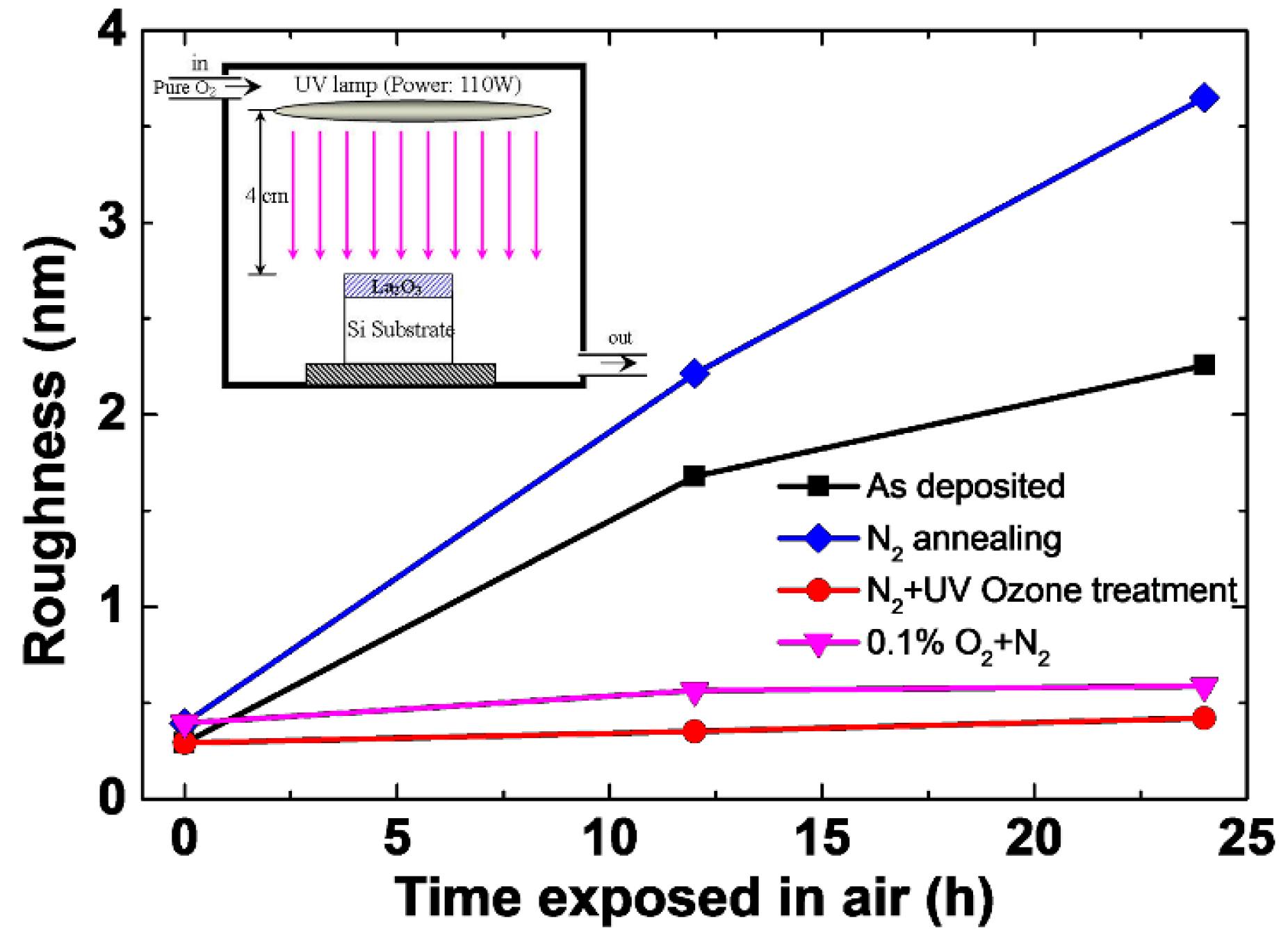




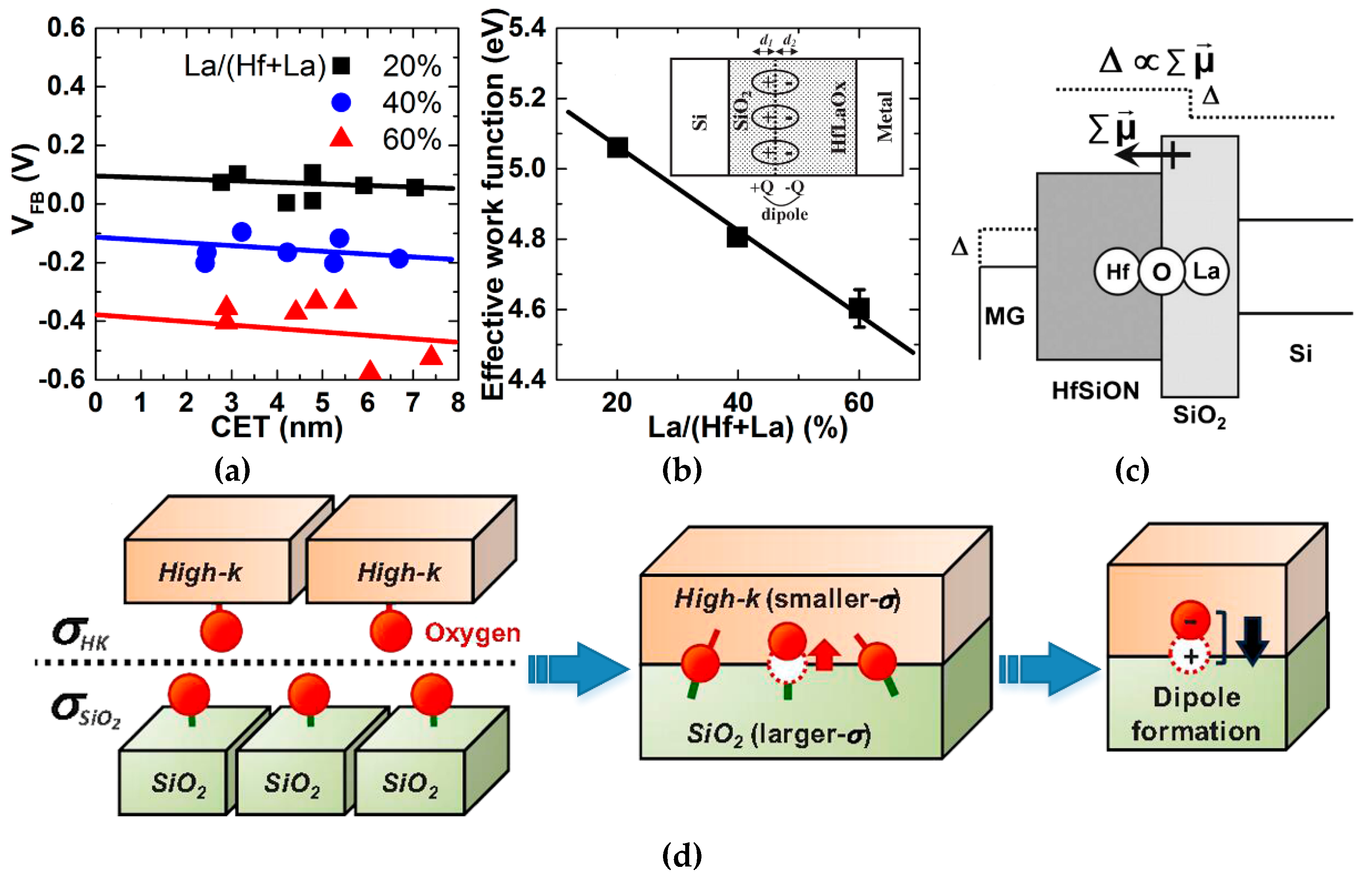

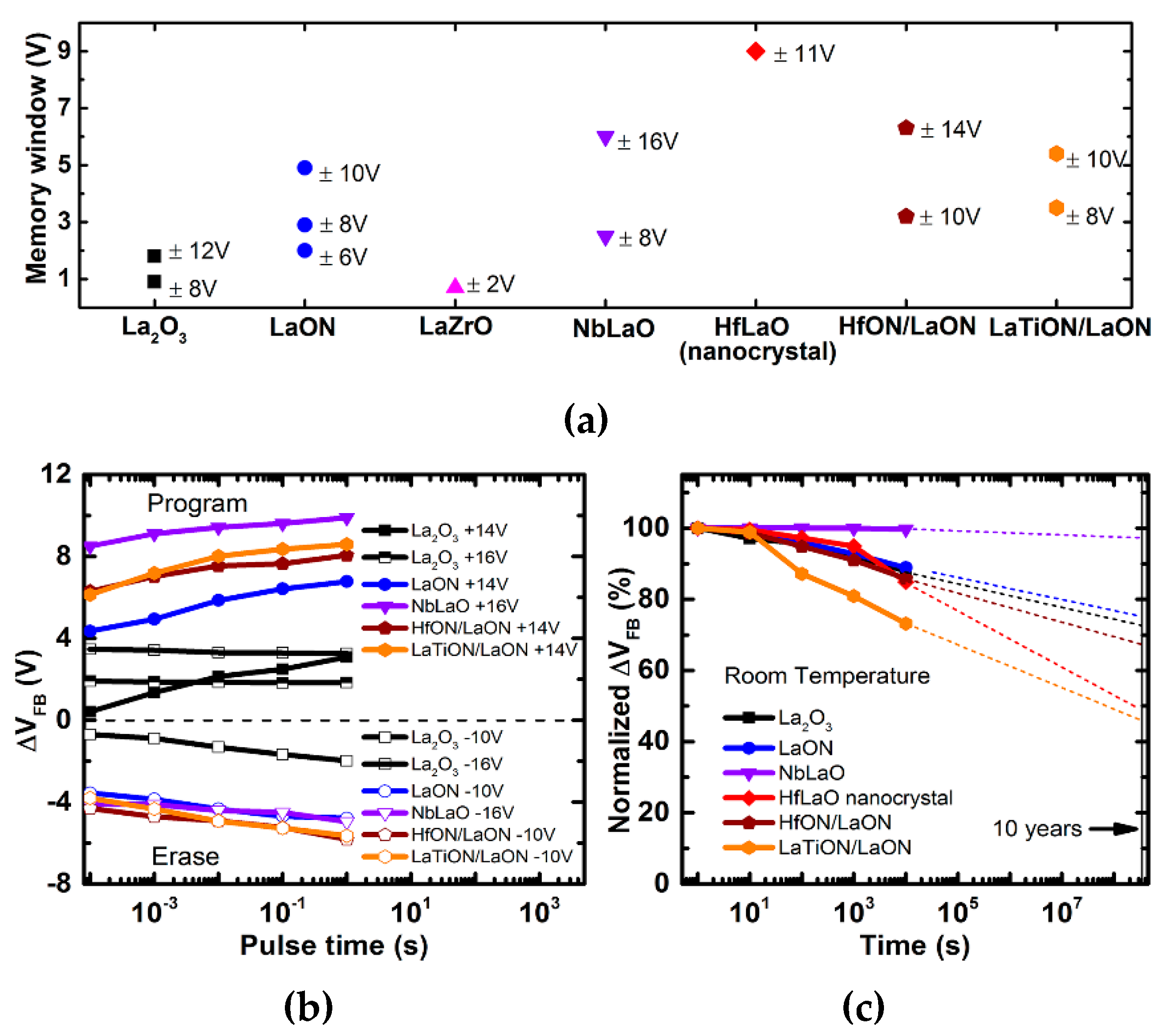
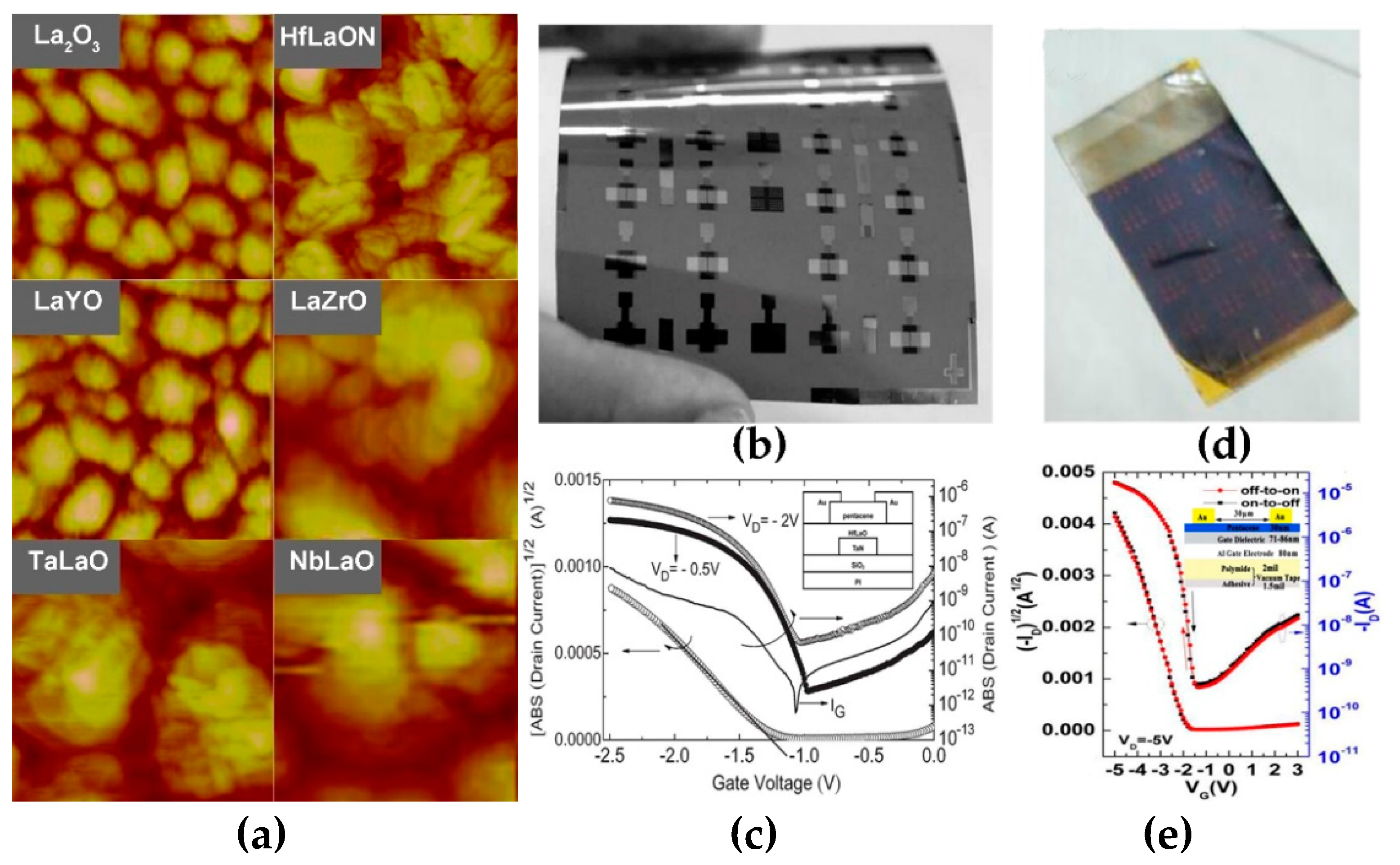
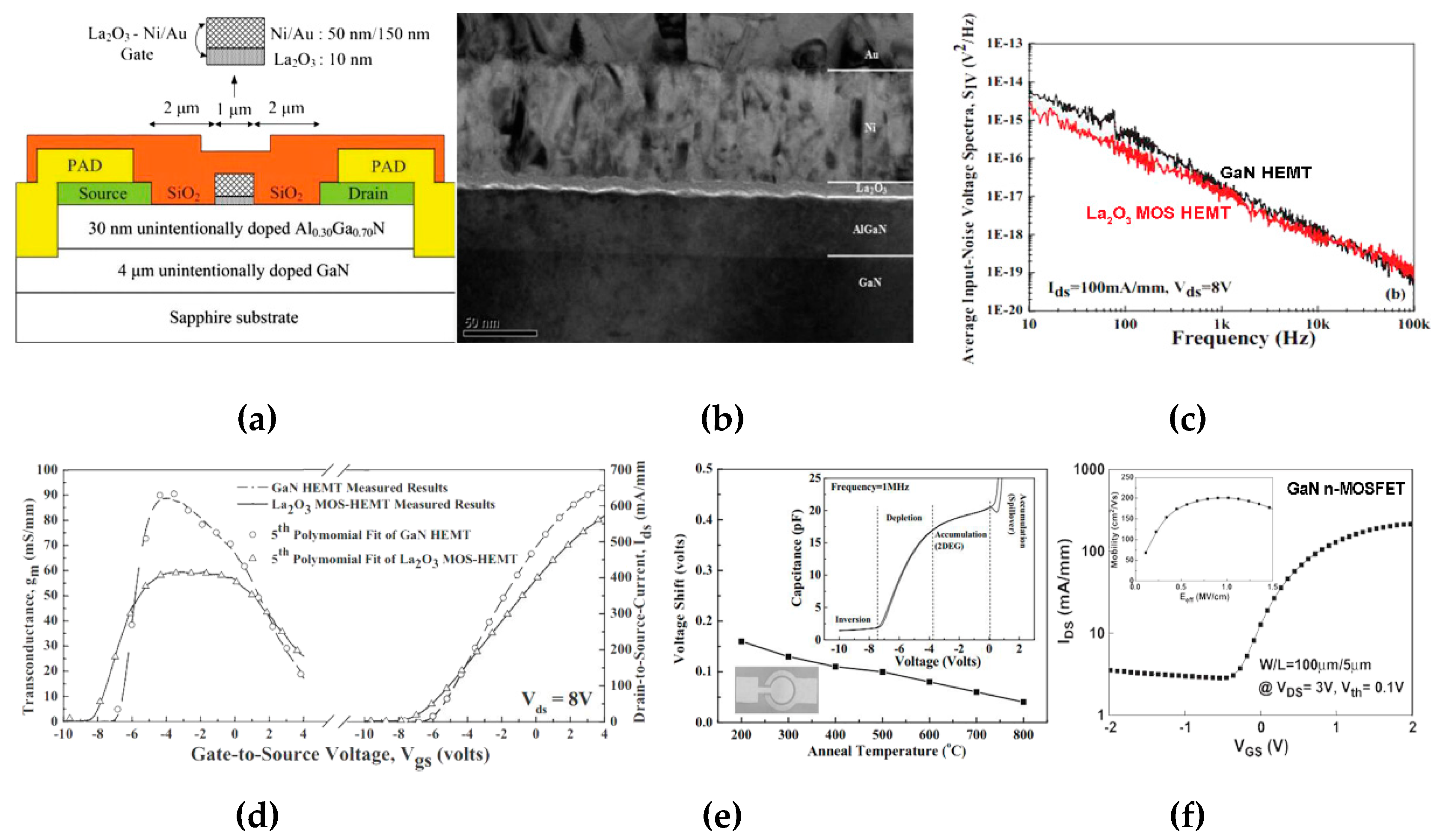

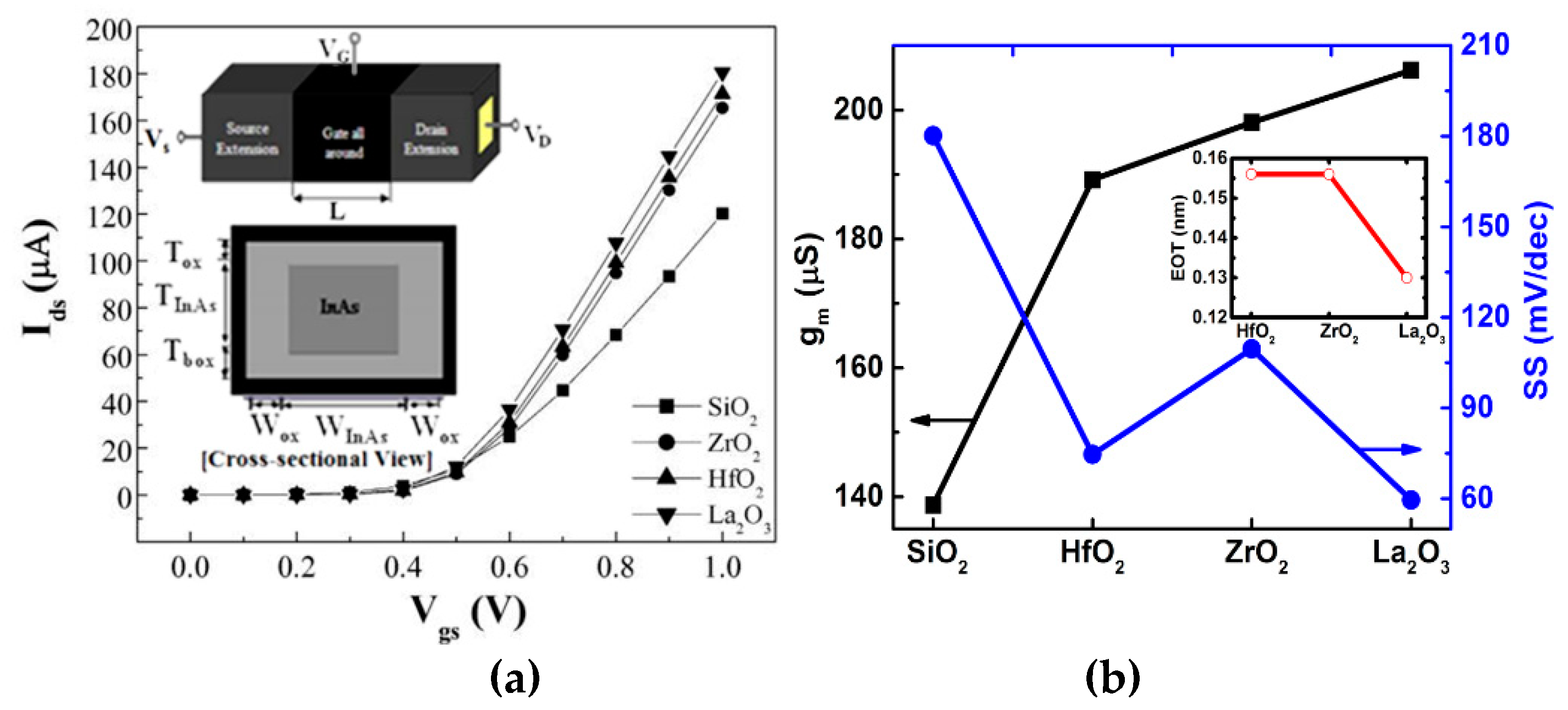
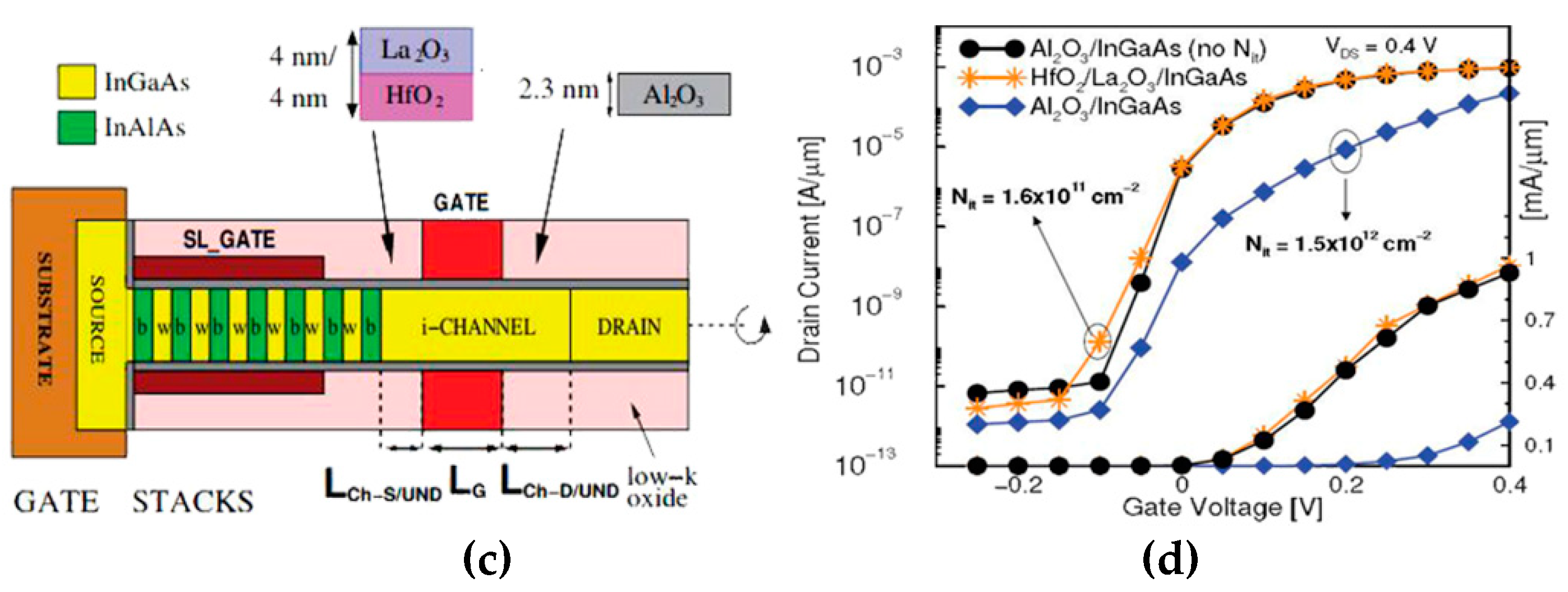
| Gate Length (nm) | 22 | 16 | 11 | 8 |
| Dielectric thickness (nm) | 0.8 | 0.6 | 0.4 | 0.3 |
| Junction depth (nm) | 11.0 | 8.0 | 5.5 | 4.0 |
| Channel depletion thickness (nm) | 11.0 | 8.0 | 5.5 | 4.0 |
| Dielectric | Deposition | Annealing | EOT (nm) | μeff, max (cm2/Vs) | |Vth| (V) | SS (mV/dec) |
|---|---|---|---|---|---|---|
| La2O3/LaSiO [92] | E-Beam | 500 °C, 30 min | 1.15 | 300 | 0.4 | 66 |
| LaAlO3 [97] | Sputtering | 700 °C, 30 s | 1.73 | 213 | ~0.05 | 69 |
| HfLaO [99] | Sputtering | 900 °C, 30 s | 1.3 | 225 | ~0.05 | − |
| HfLaSiO [100] | PVD | 850 °C, 1 min | 1.2 | 160 | − | − |
| LaYO [101] | E-Beam | 600 °C, 5 min | 1.7 | 181 | 0.59 | 95 |
| LaZrO [102] | ALD | 500 °C, 5 min | 1.27 | − | 0.43 | 71 |
| LaTiO [103] | PVD | 600 °C | 0.63 | 300 | 0.12 | − |
| Dielectrics | La2O3 [114] | HfLaO [114] | TaLaO [115] | NbLaO [42] | ZrLaO [116] | LaAlO3 [117] |
|---|---|---|---|---|---|---|
| µsat(cm2·V−1·s−1) | 16.6 | 35.1 | 23.4 | 28.0 | 67.2 | 5.4 |
| Vth (V) | 2.14 | 3.3 | 2.4 | 1.84 | 2.59 | 0.29 |
| Hysteresis (V) | −0.61 | −0.03 | 0.1 | −0.07 | −0.56 | − |
| Ion/Ioff (107) | 1.7 | 0.51 | 2.6 | 3.6 | 0.11 | 0.011 |
| SS (mV/dec) | 210 | 206 | 177 | 170 | 240 | 98 |
| Cox (µF/cm2) | 0.21 | 0.24 | 0.262 | 0.26 | − | 0.23 |
| k | 8.5 | 10.9 | 11.8 | 10.1 | 8.9 | 10.4 |
| RMS (nm) | 0.96 | − | 0.51 | 0.24 | 0.82 | − |
| Dielectrics | La2O3 [118] | HfLaO [119] | HfLaON [120] | ZrLaO [121] | TaLaO [41] | LaYO [118] | NbLaO [122] |
|---|---|---|---|---|---|---|---|
| µsat(cm2·V−1·s−1) | 0.091 | 0.71 | 0.71 | 0.72 | 1.21 | 0.33 | 1.14 |
| Vth (V) | −2.51 | −1.3 | −0.69 | 0.97 | 2.66 | −2.45 | −1.35 |
| Ion/Ioff (104) | 0.87 | 10 | 1.99 | 0.96 | 3.21 | 0.24 | 29 |
| SS (V/dec) | 476 | 78 | 427 | 578 | 339 | 646 | 208 |
| Cox (µF/cm2) | 0.223 | 0.95 | 0.297 | 0.236 | 0.234 | 0.222 | 0.222 |
| k | 7.54 | 21.7 | 11.5 | 10.6 | 10.9 | 8.46 | 10.8 |
| RMS (nm) | 0.96 | − | 0.138 | − | 0.357 | − | 0.326 |
| Dielectric | La2O3 [56] | ZrO2 [127] | LaON [128] | HfO2 [129] | LaTiON [130] | HfTiON [131] | HfO2 [132] |
|---|---|---|---|---|---|---|---|
| IPL | − | La2O3 | − | LaON | − | LaTaON | TaON/LaON |
| Deposition | E-beam | ALD | Sputtering | Sputtering | Sputtering | Sputtering | Sputtering |
| Tox (nm) | 5.5 | 7.5 | 8 | 10 | 8 | 7 | 8 |
| k | − | 14.7 | 18.8 | 19.2 | 24.6 | 27.7 | 20.9 |
| Jg (A/cm2) at VFB+/−1 V | 1 × 10−4 | − | 2.89 × 10−4 | 5.53 × 10−4 | 2.2 × 10−3 | 7.8 × 10−4 | 1.77 × 10−4 |
| CET (nm) | − | 1.92 | − | 2.0 | 1.2 | 1.1 | 1.49 |
| Dit (cm−2·ev−1) | 8 × 1011 | 1.2 × 1012 | 4.96 × 1011 | 4.2 × 1011 | 3.1 × 1011 | 7.8 × 1011 | 5.32 × 1011 |
| Dielectric | La2O3 [136] | LaYO [137] | LaAlO3 [138] | LaLuO3 [139] | TaYON [140] | ZrON [141] | NbAlON [142] | LaTiON [143] |
|---|---|---|---|---|---|---|---|---|
| IPL | Si | − | − | − | LaTaON | LaGeON | LaAlON | LaON |
| Deposition | Sputtering | ALD | MBD | ALD | Sputtering | Sputtering | Sputtering | Sputtering |
| Tox (nm) | 15 | 14 | 10 | 12 | 10 | 10 | 10 | 10 |
| k | 7.5 | 22 | 6.8 | 25 | 22.9 | 12.7 | 25.5 | 25.3 |
| Jg (A/cm2) at VFB+/−1 V | 1.2 × 10−5 | − | 8 × 10−8 | − | 1.3 × 10−5 | 3.8 × 10−5 | 6.2 × 10−6 | 2.3 × 10−5 |
| CET (nm) | 7.8 | 2.48 | 5.73 | 1.87 | 1.71 | 3.07 | 1.48 | 1.54 |
| Hysteresis (mV) | 260 | − | 30 | − | 35 | 30 | 45 | − |
| Dit (cm−2·ev−1) | 1.2 × 1012 | 5 × 1011 | 5 × 1010 | 7 × 1011 | 9 × 1011 | 1.2 × 1012 | 7 × 1011 | 1.05 × 1012 |
© 2019 by the authors. Licensee MDPI, Basel, Switzerland. This article is an open access article distributed under the terms and conditions of the Creative Commons Attribution (CC BY) license (http://creativecommons.org/licenses/by/4.0/).
Share and Cite
Liu, L.N.; Tang, W.M.; Lai, P.T. Advances in La-Based High-k Dielectrics for MOS Applications. Coatings 2019, 9, 217. https://doi.org/10.3390/coatings9040217
Liu LN, Tang WM, Lai PT. Advances in La-Based High-k Dielectrics for MOS Applications. Coatings. 2019; 9(4):217. https://doi.org/10.3390/coatings9040217
Chicago/Turabian StyleLiu, L. N., W. M. Tang, and P. T. Lai. 2019. "Advances in La-Based High-k Dielectrics for MOS Applications" Coatings 9, no. 4: 217. https://doi.org/10.3390/coatings9040217
APA StyleLiu, L. N., Tang, W. M., & Lai, P. T. (2019). Advances in La-Based High-k Dielectrics for MOS Applications. Coatings, 9(4), 217. https://doi.org/10.3390/coatings9040217




